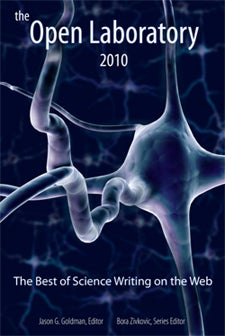Do Japanese people have a special sushi-digestion gene? What are 10 things everyone must know about comets? Can giraffes swim?
Inquiring minds from the Internet’s vibrant scientific online community want to know.
The Open Laboratory 2010, an anthology showcasing the best science writing on the Web, features pieces on biology, psychology, physics, astronomy and everything in between, according to its editor Jason Goldman, a doctoral student in developmental psychology in USC Dana and David Dornsife College of Letters, Arts and Sciences.
The anthology includes articles by professional science writers, poets, artists and undergraduates, as well as Pulitzer Prize-winning author Deborah Blum, said Goldman, who sorted through 900 submissions of scientific musings to create the final collection of 50 posts.
Among the entries are a humorous ode to a lab rat by a blogger known as Cuttlefish, a look at a Neanderthal’s cranium by Carl Zimmer and a report on shark attacks by Michelle Clement, a student in the Midwest.
Goldman, a blogger on ScienceBlogs.com, had to ensure that the posts translated well from the Internet to “dead-tree printing.” He also managed every other publication aspect that ultimately yielded a book, including rights and permission, artwork, typesetting and the solicitation of reviews and quotes of “praise” on the back cover.
To help him accomplish all this in under four months, Goldman said he drew upon help from the science online community itself via a method called “crowd-sourcing” to help evaluate submissions.
Goldman also relied on peer review research tools such as ResearchBlogging.org to help “cut out noise and raise the signal” for blog submissions.
“The complete transparency of the process and the community involvement in the entire project are the biggest strength of it,” Goldman said. “Everyone in the science blogging world feels a little bit of pride in it and a little bit of ownership in it.”
According to a post by Bora Zivkovic, the book’s series editor and blog editor at Scientific American, the annual anthology is embraced by bloggers, media outlets and journals, including Nature.

“The aim of the book is twofold: first, to showcase the quality of science blogging to the audience that does not read blogs and perhaps has a negative opinion of blogs due to the anti-blog propaganda in the mainstream media, and second, to build and strengthen the science blogging community,” he wrote.
Goldman rose from scientific obscurity to relative fame in a little more than a year when he first penned his blog, The Thoughtful Animal (scienceblogs.com/thoughtfulanimal). “The rise to visibility happened very fast for me,” he said. “Last year I wasn’t even blogging yet.”
Goldman now parlays his science expertise into stories for mainstream outlets, including the Guardian, Scientific American and Jewish Journal, among others.
And for those who checked their science gene at the door of the hospital delivery room, don’t fret. One of the goals, Goldman said, was to make science writing more accessible to the everyman.
“Science is not about middle-aged white men in lab coats with no sense of humor,” he said.
To order the anthology in either pdf or book format, visit online book publisher Lulu.com. All money goes to covering production expenses and then back into the science community.
And apparently giraffes can in fact swim — but not all that well.